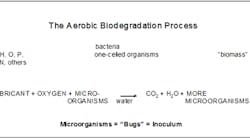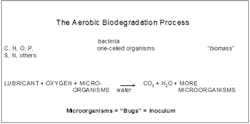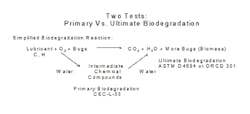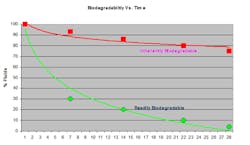Web Exclusive - Keeping it clean with bio-based hydraulic fluids
There is growing concern regarding the environmental impact and associated costs of lost petroleum-based fluids. The National Oceanic and Atmospheric Administration (NOAA) estimates that more than 700 million gal of petroleum enter the environment each year, more than half of which is through irresponsible and illegal disposal. Industry experts estimate that 70 to 80% of hydraulic fluids leave systems through leaks, spills, line breakage, and fitting failure. Petroleum is persistent and toxic. It damages living organisms including plants, animals, and marine life for many years. In addition, the Coast Guard, EPA, and local governments are increasing the range of responsibility of lubricant releases including significant fines and clean-up costs.
In addition to regulatory pressure, equipment operators are frequently faced with clients and stakeholders who are concerned with petroleum-based hydraulic fluids getting into the environment. Even a small amount of petroleum could contaminate an area and cause it to be classified as hazardous.
Prevention is the best environmental protection
As demands on lubricant systems increase, the likelihood of accidental release of fluids also increases. Increased operating temperatures, pressures, and working cycles shorten the life of circuit components. The single best approach to protecting the environment, the equipment, and the operation is to prevent leaks and spills through good routine maintenance. A good preventative maintenance program will:
- Increase productivity because equipment is used more,
- Better utilize in-shop maintenance because there is less emergency work,
- Improve control of spare part inventory and reduce parts usage,
- Reduce equipment down time,
- Reduce safety hazards,
- Increase equipment life,
- Reduce fines and clean-up costs due to environmental release, and
- Reduce down time related to environmental release.
Even with the best maintenance practices, hydraulic leaks and spills are almost inevitable. With that in mind, more and more operators are exploring the use of environmentally preferable alternatives.
Bio-based means less regulation
There are increasing regulatory pressures from the EPA, Coast Guard, and other environmental organizations. While small releases will not result in a Resource Conservation and Recovery Act (RCRA) clean up, large spills will. All petroleum hydraulic fluid spills are “reportable events.” These events involve a great deal of clean-up cost, administrative procedures, and punitive fines that can range from tens of thousands to hundreds of thousands of dollars.
While spilling large quantities of biodegradable hydraulic fluid is still considered under RCRA to be a reportable event, agencies are required to evaluate “bio-based oils” differently than petroleum-based oils. As awareness of biodegradable fluid increases, state and federal agencies are becoming more lenient regarding fines and clean-up costs. In fact, there are several case studies of equipment releasing several hundred gallons of vegetable-based hydraulic fluid into environmentally sensitive areas with no fines and minimal clean-up expense. In most instances, the operator was able to continue working while clean-up efforts were underway. Since the fluids were biodegradable and non-toxic, there was no long-term negative effect to the ecosystem.
There is a common misperception that the Coast Guard or other agencies approve oils based on the oil not leaving a sheen. This is not true. The Coast Guard does not approve, recommend, or endorse any fluids. Furthermore, the Coast Guard does not approve or recommend any test procedures, but rather, follows United States statute laws. The oil sheen that is frequently referenced is inferred from the Clean Water Act as defining “any substance that leaves a sheen, emulsification, or discoloration, as a pollutant and be subject to appropriate fines and regulations governing pollutants.” The Coast Guard also relies on the guidelines as outlined by equipment manufacturers and highly favors the use of bio-based and biodegradable fluids. Figure 1 shows the process of biodegradation. Biodegradation is the process of chemical breakdown or transformation of a material caused by organisms or their enzymes.
There are two commonly used measurements for biodegradation. The first is “primary degradation” which measures reduction of the carbon and hydrogen bonds (C-H) in the initial solution; this is the reduction of the amount of the lubricant. The most widely used test that measures this decrease is the CEC-L-33-A-93.
The second measurement of biodegradation is “secondary degradation” or “ultimate degradation.” This measures the evolution of CO2 through the biodegradation. The usual test for this is the OECD 301or the ASTM D4684. Figure 2 shows both processes.
Biodegradability defined
There is no single definition of biodegradability. Throughout the United States and internationally there is a wide range of environmentally preferable definitions. The ASTM 6064 has defined biodegradable as a function of degree of degradation, time, and test methodology. Figure 3 shows the different classifications of biodegradation.
Despite these definitions, there are two widely used designations for biodegradability, readily and inherently. Readily biodegradable is defined as degrading 80% within 21 days as measured by the decrease of a test sample. This type of degradation is preferable because in most cases, the fluid will degrade long before environmental damage has occurred. Because of this, little is required in terms of long-term bio-remediation. Vegetable-based lubricants and some synthetic ester-based products exhibit ready biodegradation.
There are several petroleum-based lubricants that claim “inherent biodegradability.” Inherent biodegradation is defined as having the propensity to biodegrade, with no indication of timing or degree. These types of products can persist in the environment for years, continuing to cause substantial damage. They require long-term remediation due to the environmental persistence. Typically, these products are petroleum-based, like conventional lubricants. Figure 4 illustrates the difference in degradation timing of a readily biodegradable product compared to an inherently biodegradable product.
This graph easily shows the difference between a readily biodegradable product and an inherently biodegradable one. The EPA and Coast Guard use this differentiation when evaluating an oil release.
Eco-toxicity is critical to living organisms
Another measurement to determine environmental effect of a lubricant is “eco-toxicity.” Historically, tests for eco-toxicity have concentrated on the aquatic environment with a number of standard test procedures. Most typically, the tests are for “acute toxicity.” This is a measurement of the concentration required to kill various organisms over a short period of time ranging from 24-96 hours. Depending on the tests and its end points, the toxicity of a fluid is described by a loading rate that has a 50% effect (EL50) or causes 50% mortality (LL50) after the stated time. That is, at what concentration of fluid one half of the sample organisms die. Figure 5 shows the different classifications of ecotoxicity.
Performance of bio-fluids
There is a wide variety of performance levels among biodegradable products. When an environmentally preferable product is required outside the common temperatures range, a biodegradable synthetic is usually required. While offering biodegradation, these products can operate in temperatures in excess of 400° F and still offer long fluid life. As would be expected, these products are significantly more expensive.
Care must be taken in choosing the appropriate product for the specific application. Responsible Environmentally Preferable Product (EPP) suppliers can clearly indicate their definition of “environmentally preferable.” The Federal Trade Commission has been very specific in its requirements for environmental claims and state “look for claims that give some substance to the claim, the additional information that explains why the product is environmentally friendly.” Many “would-be” EPP suppliers use misleading environmental claims such as “inherently biodegradable” or “food-grade.” Suppliers should be able to support performance claims with testing data. These data can include standard industry tests (ASTM), field-testing, and equipment manufacturer tests. Unless an EPP supplier specializes in environmentally preferable products, they are probably not an expert in the field.
Product demonstration is key
When exploring the use of environmentally safe hydraulic fluids, one quickly observes that not all environmentally safe fluids or the companies that promote them are the same. It seems almost every oil company has some type of “environmentally safe” oil. One must read the fine print to understand what they were really selling.
Because there is no standard for environmentally preferable fluids, many different types of products claim to be environmentally safe. For the most part, they fall into four major classes of products:
- Inherently biodegradable products are those that will break down “some day” and the time to do so is usually measured in years. The environmentally safe aspect is that they are made from either food grade oil or highly refined petroleum-based fluids and contain no heavy metals in the additives. While not truly biodegradable, they can have reduced toxicity.
- USDA H1 “food grade” lubricants that are designated for use in food processing plants. They are designed for light duty applications where the fluid does not come in contact with food. Food grade oils are typically impractical for severe marine applications. In addition, they are toxic; in fact an entire batch of food must be discarded in the event of contact with the lubricant. Finally, they are petroleum-based and therefore environmentally persistent (inherently biodegradable or non-biodegradable) meaning they will be toxic to marine life for long periods of time.
- Readily biodegradable products such as vegetable-based fluids break down into safe, environmentally compatible components (CO2 and H2O) by more than 90% in 28 days or less. They are also non-toxic so they don’t kill marine life. They typically are designed for low operating temperatures (less that 220°F).
- Synthetic products usually offer enhanced performance as compared to vegetable or petroleum products. Some can be readily biodegradable and non-toxic and can withstand operating temperatures over 400°F.
History paints a picture
Historically, vegetable-based fluids had not exhibited sufficient performance for most hydraulic applications. There were several reasons for this.
Fluid formulations — Traditionally, a lubricant is compounded from petroleum-based oil and a variety of performance chemistries. Early pioneers in the vegetable-based lubricant market used the same chemistry that was used for petroleum lubricants in vegetable based-oils. It was a great idea, but it didn’t work. The characteristics of vegetable oils are vastly different than those of petroleum oils. Vegetable oils had to be formulated for their individual strengths and limitations. Today, there are several vegetable-based products on the market. They offer good performance and a fair price. While all vegetable-based lubricants have temperature limitations, there are some that are better than others. One should check with their lubricant supplier to determine their maximum and minimum operating temperatures. While most vegetable-based lubricants have a maximum operating temperature of 140°F, there are some that offer protection as high as 220°F. Similarly, most vegetable-based lubricants offer good performance to 30°F, yet there are some that flow below –30°F.
Fluid choice — Even the highest performing bio-based fluids have operating limitations in terms of temperature and life expectancy. Using a bio-based fluid in an application higher than 220°F (and as low as 160°F for some fluids) will cause premature and possibly catastrophic equipment failure. There are numerous cases in which using a vegetable-based fluid in the wrong application was a major contributor to the failure. In extreme high temperatures and environmentally sensitive applications, readily biodegradable synthetic fluids should be utilized.
Fluid care — Traditional bio-based fluids offer unique performance characteristics; however they require special care to maximize their useful life. While water is the enemy of all lubricants, most bio-based fluids are more susceptible to hydrolytic breakdown, the result of which can be acid formation. These acids can attack seals, increase wea,r and accelerate fluid aging. Proper filtering will prolong the useful life of these fluids.
Pile drivers lead the way
There are many examples of successful long-term users of environmentally safe fluids. They have had to adapt over time to maximize the utility of the fluids. One example is American Piledriving Equipment Company (APE). For the past 20 years, APE has lead the piledriving industry toward environmental responsibility by exclusively utilizing vegetable-based hydraulic fluids. These biodegradable and non-toxic oils cost more than conventional petroleum-based fluids, but in the long term, save operators thousand of dollars by reducing fines, oil clean-up costs, and downtime. In addition, using agriculturally based products has helped the environment because it breaks down quickly in the environment (readily biodegradable), does not hurt wildlife (non-toxic), and reduces dependence on petroleum, a nonrenewable resource. Finally, using vegetable-based hydraulic fluids has improved the performance of vibro-hammers because of its excellent lubricating properties.
In April of 1989, John White, now the President of APE, developed a vibro-hammer that was smaller in size, yet could perform as well as much larger hammers. As a result of its smaller size, stronger innovative components such as tungsten were required. These hammers were used to help Boeing Corp. protect existing structures from earthquake damage. They soon found their way into Prudhoe Bay, one of the most pristine environments in the world. The environmental regulations in Prudhoe Bay are extremely strict with fines amounting to $20,000 per square foot of oil spill. Any jobsite — and in particular a pile driving site — is susceptible to oil leaks and spills and the risk of fine was too great. In fact, one option, to lay protective mats down over the entire working area was evaluated but was deemed impractical.
About this time, there were several initiatives in Europe to utilize vegetable oil as a base fluid for lubricants. Scandinavian loggers were evaluating the use of rapeseed oil for chain oils while the Swiss were experimenting with vegetable-base two cycle oils for outboard motors. APE began to explore the use of vegetable oil as the base for a hydraulic fluid and found it to be quite possible.
In mid-1992, APE made the decision to move to vegetable oil in all their equipment. There were several obstacles to overcome, however. First, was the performance of the fluid. Early vegetable-based products did not offer long-term protection for heavy-duty applications. They broke down rapidly at the temperature of a working vibro-hammer and had to be changed out more frequently than conventional petroleum products. APE needed to address the cooling system and sump size of the oil. Secondly, because there was limited supply of vegetable oils, if a contractor lost oil it would be difficult to locate a supply of appropriate product. To overcome this, APE installed a backup gravity feed reservoir that allowed the operator to refill his unit by simply pulling a lever. With these obstacles taken care of, APE went system wide with environmentally safe vegetable hydraulic fluids.
The fluid worked well, but still had a few limitations such as cold temperature performance, rust potential, and availability. However, in 1998, newer formulations were able to improve upon these limitations. In fact, with the improvements to the fluids, the APE hammers are able to run cooler, extending the life both of the hammer and the hydraulic fluid. Since then, APE has expanded the use of vegetable-based, biodegradable products to include diesel fuel, grease, gear oil and others.
Saving money in the long run
While the vegetable-based fluids cost more on a per gallon basis, the following four case studies actually show a cost savings by the utilization of the environmentally safe fluids.
While driving piles in the Sacramento River, a piledriving company’s hydraulic fitting broke, dumping 600-700 gal of vegetable hydraulic fluid into the river. After initial traditional emergency response; containment, recovery, and reporting, the California Department of Natural Resources allowed the operator to continue working. They agreed to wait 30 days before evaluating fines and long-term remediation. At that time, the water showed no oil, and the fish and plants were thriving. Therefore, there was no fine and no clean up required. As a result, the company saved $30,000 in downtime, $20,000 in fines, and $50,000 in cleanup.
The Bonneville Hydroelectric Dam used an APE Kong 400 to install protecting piles to divert fish from the damn. Using petroleum hydraulic fluid would have jeopardized the very fish the project was designed to protect. The project won environmental awareness award from the Society of Military Engineers (SAME).
While driving sheet piles off of San Juan, Puerto Rico, a sheet cut a hydraulic hose. At least 300 to 400 gal of EnviroLogic 146 hydraulic fluid were released prior to shutting down the machine. The environmental regulator was on site and reviewed the Material Safety Data Sheet. Subsequently, no cleanup other than initial containment and recovery was required. The hose was replaced and the operation was able to continue.
While driving pile in Elliot Bay, a Seattle contractor discovered that a hydraulic hose ruptured and allowed approximately 200 gal of EnviroLogic 146 vegetable hydraulic fluid into the bay. While the contractor used their best efforts to contain and clean the spill, Washington State Resource Damage Assessment (RDA) committee reviewed the event. According to “Oil Spill Compensation Schedule Rule” (WAC 173-183) the contractor was liable, based on amount and type fluid, location and time of the spill, for a fine of approximately $40,000. With support of the biodegradable oil supplier, the RDA committee reviewed the “true” environmental impact, and the fine was eliminated.
Proof is in the performance
The true proof of performance is the field. Any fluid supplier should support their customers with routine oil monitoring and interpretation of the results. Because biodegradable products behave differently than conventional petroleum products, one should not count exclusively on the conventional oil analyst’s interpretation test labs results.
It is important to partner with a biofluid supplier, with enough field and technical experience to support an oil-monitoring program and to be willing and able to support product changes.
Many factors should be considered when choosing a biodegradable fluid. The key considerations to be evaluated prior to selecting any fluid include:
- Temperature,
- Pressure,
- Seals and elastomers,
- Water intervention,
- Fluid life,
- Spill potential, and
- Client choice.
Readily biodegradable lubricants can save time and money while protecting the environment; however, they must be properly maintained. Because the key to long fluid life and top tier performance is keeping the fluid clean and dry, proper filtration is essential.
For more information, visit www.terresolve.com or call (800)-661-3558.






